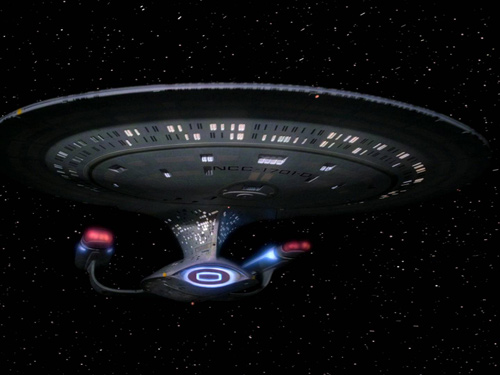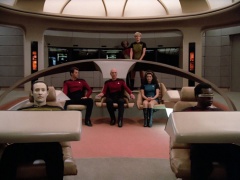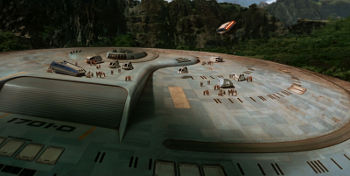U.S.S. Enterprise NCC-1701-D
| Registry | NCC-1701-D |
| Class | Galaxy |
| Commissioned | SD 40759.5 (2363) |
| Status | Destroyed SD 48632.4 (2371) |
| Advertising |
A Galaxy class extended-duration starship and the flagship of Starfleet, the Enterprise was commanded by Captain Jean-Luc Picard.[1] The Enterprise was commissioned on Stardate 40759.5, more than a decade after the first two spaceframe components, the Deck 10 computer core elliptical compression member and the starboard main longitudinal compression bulkhead, were gamma-welded during a brief ceremony on 3 June 2350, at the Utopia Planitia assembly site, in synchronous orbit 16,625km above the surface of Mars.[2]
In 2358, an ejectable bridge module was docked to the Enterprise. A minimum flight test program crew completed preliminary training aboard ship, and the Enterprise was launched from its dock on maneuvering thrusters. The flight test crew continues developmental shakedown trials in Mars space through 2359, when the Enterprise was at last declared deep-spaceworthy and warp-capable. By 2360, the Enterprise had achieved warp flight in the outer Sol system. An operational bridge module was docked, and in 2363, the Enterprise was officially commissioned in a ceremony at Utopia Planitia. The U.S.S. Galaxy NCC-70637 and the U.S.S. Yamato NCC-71807, the first two Galaxy class starships completed, sent congratulatory messages via subspace radio.[2]
With a total of 42 decks, the Enterprise was twice the length and had eight times the interior space of the Constitution class ships of the previous century, and carried a combined crew and passenger load of more than one thousand. When the Enterprise left the Utopia Planitia Fleet Yards, approximately 35% of the ship's internal volume had not yet been filled with room modules, and remained as an empty spaceframe for future expansion and mission-specific applications.[2]
Defensive systems included 11 Type X phaser arrays, 250 photon torpedoes, and a high capacity shield grid; there were some 4,000 power systems in all aboard the ship. Full acceleration time from reverse, sub-light impulse through nominal top warp speed, warp 9, was 0.03 milliseconds.[2] The ship achieved a maximum speed of warp 9.5 when pursued by Q; at warp 9.3 its engines had passed the red line.[1]
An average day aboard ship, according to Lieutenant Commander Data, included four birthdays, two personnel transfers, two chess tournaments, a secondary school play, four promotions, the celebration of the Hindu Festival of Lights—and a birth and wedding.[3]
During the Borg incursion of 2366, Decks 23-25 were sliced open by the enemy during the final battle over Earth,[4] requiring a refit at Earth Station McKinley which lasted about 6 weeks.[5] It was far less damage than the kamikaze warp-driven collision acting-Captain William Riker had readied as a last recourse, however.[4] During that refit, the starship received a phaser upgrade as well as damage repair and a new dilithium chamber articulation frame.[6]
The ship off-loaded the original three Danube class runabouts and several officers at Deep Space 9 following the Cardassian withdrawl from Bajor.[7] The Enterprise was destroyed in 2371, after an attack by renegade Klingons breached the warp core; although the saucer section separated before the breach, the force of the explosion caused it to crash on Veridian III. Fortunately, losses were minimal, though the ship itself was beyond repair.[8]
Image Gallery
U.S.S. Enterprise saucer crashed (ST07)
Ships Named Enterprise
Prime Timeline
H.M.S. Enterprize • U.S.S. Enterprise (1775) • U.S.S. Enterprise CV-6 (Yorktown class aircraft carrier) • U.S.S. Enterprise CVN-65 (Nimitz class aircraft carrier) • Enterprise OV-101 (Space Shuttle) • U.S.S. Enterprise XCV-330 (XCV class) • Enterprise NX-01 (NX class) • U.S.S. Enterprise NCC-1701 (Constitution class) • U.S.S. Enterprise NCC-1701-A (Constitution II class) • U.S.S. Enterprise NCC-1701-B (Excelsior class) • U.S.S. Enterprise NCC-1701-C (Ambassador class) • U.S.S. Enterprise NCC-1701-D (Galaxy class) • U.S.S. Enterprise NCC-1701-E (Sovereign class) • U.S.S. Enterprise NCC-1701-F (Odyssey class) • U.S.S. Enterprise NCC-1701-G (Constitution III class)
Columbia Timeline
H.M.S. Enterprize • U.S.S. Enterprise (1775) • U.S.S. Enterprise CV-6 (Yorktown class aircraft carrier) • U.S.S. Enterprise CVN-65 (Nimitz class aircraft carrier) • Enterprise OV-101 (Space Shuttle) • U.S.S. Enterprise XCV-330 (XCV class) • Enterprise NX-01 (NX class) • U.S.S. Enterprise NCC-1701 (Constitution class) • U.S.S. Enterprise NCC-1701-A (Constitution II class) • U.S.S. Enterprise NCC-1701-B (Excelsior class) • U.S.S. Enterprise NCC-1701-C (Ambassador class) • U.S.S. Enterprise NCC-1701-D (Galaxy class) • U.S.S. Enterprise NCC-1701-E (Sovereign class) • U.S.S. Enterprise NCC-1701-F (Odyssey class) • U.S.S. Enterprise NCC-1701-G (Constitution III class)
FASA Timeline
U.S.S. Enterprise (1775) • U.S.S. Enterprise CV-6 (Yorktown class aircraft carrier) • U.S.S. Enterprise CVN-65 (Nimitz class aircraft carrier) • Enterprise OV-101 (Space Shuttle) • U.S.S. Enterprise XCV-330 (Declaration class) • U.S.S. Enterprise NCC-1701 (Constitution class) • U.S.S. Enterprise NCC-1701-A (Enterprise class) • U.S.S. Enterprise NCC-1701-B (Excelsior class) • U.S.S. Enterprise NCC-1701-C (Alaska class) • U.S.S. Enterprise NCC-1701-D (Galaxy class)
First Splinter Timeline
U.S.S. Enterprise NCC-1701-E (Sovereign class)
Kelvin Timeline
H.M.S. Enterprize • U.S.S. Enterprise (1775) • U.S.S. Enterprise CV-6 (Yorktown class aircraft carrier) • U.S.S. Enterprise CVN-65 (Nimitz class aircraft carrier) • Enterprise OV-101 (Space Shuttle) • U.S.S. Enterprise XCV-330 (XCV class) • Enterprise NX-01 (NX class) • U.S.S. Enterprise NCC-1701 (Constitution class) • U.S.S. Enterprise NCC-1701-A (Constitution II class)
KLV Timeline
H.M.S. Enterprize • U.S.S. Enterprise (1775) • U.S.S. Enterprise CV-6 (Yorktown class aircraft carrier) • U.S.S. Enterprise CVN-65 (Nimitz class aircraft carrier) • Enterprise OV-101 (Space Shuttle) • U.S.S. Enterprise XCV-330 (XCV class) • Enterprise NX-01 (NX class) • U.S.S. Enterprise (Unknown class) • U.S.S. Enterprise NCC-1701 (Constitution class) • U.S.S. Enterprise NCC-1701-A (Constitution II class)
SFC Timeline
U.S.S. Enterprise NCC-1701 (Constitution class) • U.S.S. Enterprise NCC-1701-A (Constitution class) • U.S.S. Enterprise NCC-1701-B (Excelsior class) • U.S.S. Enterprise NCC-1701-C (Ambassador class) • U.S.S. Enterprise NCC-1701-D (Galaxy class) • U.S.S. Enterprise NCC-1701-E (Sovereign class)
SFU Timeline
U.S.S. Enterprise NCC-1701 (Constitution class)
STO Timeline
H.M.S. Enterprize • U.S.S. Enterprise (1775) • U.S.S. Enterprise CV-6 (Yorktown class aircraft carrier) • U.S.S. Enterprise CVN-65 (Nimitz class aircraft carrier) • Enterprise OV-101 (Space Shuttle) • U.S.S. Enterprise XCV-330 (XCV class) • Enterprise NX-01 (NX class) • U.S.S. Enterprise NCC-1701 (Constitution class) • U.S.S. Enterprise NCC-1701-A (Constitution II class) • U.S.S. Enterprise NCC-1701-B (Excelsior class) • U.S.S. Enterprise NCC-1701-C (Ambassador class) • U.S.S. Enterprise NCC-1701-D (Galaxy class) • U.S.S. Enterprise NCC-1701-E (Sovereign class) • U.S.S. Enterprise NCC-1701-F (Odyssey class)
Mirror Universe
H.M.S. Enterprize • I.S.S. Enterprise NX-01 (NX class) • I.S.S. Enterprise NCC-1701 (Constitution class)
Myriad Universes
U.S.S. Enterprise CV-6 (E78) (Yorktown class aircraft carrier) • U.S.S. Enterprise NCC-1701-J (E76) (Universe class)
Galaxy class vessels
U.S.S. Challenger NCC-71099 • U.S.S. Dauntless NCC-71879 • U.S.S. Enterprise NCC-1701-D • U.S.S. Excalibur NCC-26517-A • U.S.S. Galaxy NCC-70637 • U.S.S. Magellan NCC-71820 • U.S.S. Odyssey NCC-71832 • U.S.S. Trident NCC-78143 • U.S.S. Trinculo NCC-71867 • U.S.S. Ulysses • U.S.S. Venture NCC-71854 • U.S.S. Yamato NCC-71807
FASA Timeline
U.S.S. Galaxy NCC-70637 • U.S.S. Enterprise NCC-1701-D • U.S.S. Yamato NCC-71807
STO Timeline
U.S.S. Challenger NCC-71099 • U.S.S. Enterprise NCC-1701-D • U.S.S. Galaxy NCC-70637 • U.S.S. Odyssey NCC-71832 • U.S.S. Venture NCC-71854 • U.S.S. Yamato NCC-71807
Mirror Universe
Myriad Universes
Notes and References
- ↑ 1.0 1.1 Roddenberry, Gene (Executive Producer). "Encounter at Farpoint". Star Trek: The Next Generation, season 1, episode 1-2 (Production number 101-102). Co-Executive Producers: Rick Berman & Maurice Hurley. Directed by Corey Allen. Written by D.C. Fontana & Gene Roddenberry. Paramount Pictures. 28 September 1987.
- ↑ 2.0 2.1 2.2 2.3 Sternbach, Rick Michael Okuda (Authors). Technical Manual. Star Trek: The Next Generation. Book. Pocket Books. 1991.
- ↑ Roddenberry, Gene et al (Executive Producers). "Data's Day". Star Trek: The Next Generation, season 4, episode 11 (Production number 185). Directed by Robert Wiemer. Story by Harold Apter. Teleplay by Harold Apter & Ronald D. Moore. Paramount Pictures. 7 January 1991.
- ↑ 4.0 4.1 Roddenberry, Gene et al (Executive Producers). "The Best of Both Worlds, Part II". Star Trek: The Next Generation, season 4, episode 1 (Production number 175). Directed by Cliff Bole. Written by Michael Piller. Paramount Pictures. 24 September 1990.
- ↑ Roddenberry, Gene et al (Executive Producers). "Family". Star Trek: The Next Generation, season 4, episode 2 (Production number 178). Directed by Les Landau. Written by Ronald D. Moore. Paramount Pictures. 1 October 1990.
- ↑ Roddenberry, Gene et al (Executive Producers). "The Drumhead". Star Trek: The Next Generation, season 4, episode 21 (Production number 195). Directed by Jonathan Frakes. Written by Jeri Taylor. Paramount Pictures. 29 April 1991.
- ↑ Berman, Rick & Michael Piller (Executive Producers). "Emissary". Star Trek: Deep Space Nine, season 1, episode 1-2 (Production number 401-402). Directed by David Carson. Story by Rick Berman & Michael Piller. Teleplay by Michael Piller. Paramount Pictures. 4 January 1993.
- ↑ Berman, Rick (Producer). Star Trek: Generations. Directed by David Carson. Story by Rick Berman & Ronald D. Moore & Brannon Braga. Screenplay by Ronald D. Moore & Brannon Braga. Paramount Pictures. 18 November 1994.



